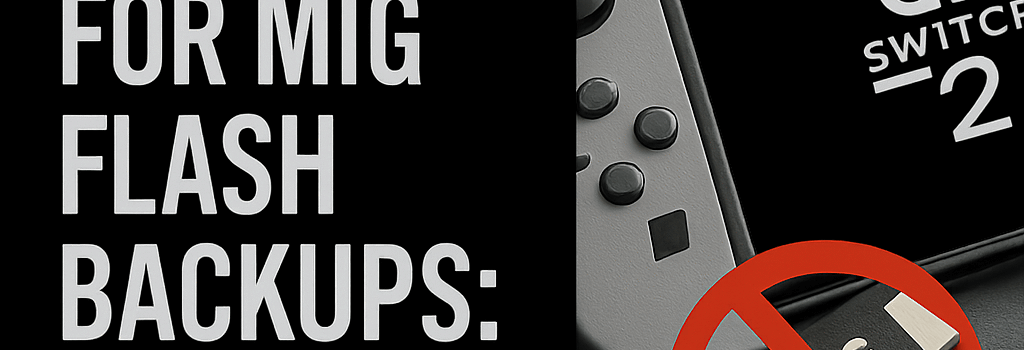Switch 2 Users Ban for Mig Flash Backups: Technical Analysis

After recent firmware updates, Nintendo has begun banning Switch 2 consoles that run game backups via the Mig Flash cartridge. Users report device-level server bans even when using legally purchased game dumps. We examine the technical measures, community fallout, and expert opinions behind this new crackdown.
Caveat Emptor: The Risks of Using Mig Flash on Switch 2
The Mig Flash cartridge, designed to let players load games from an SD card without hardware modifications, gained a new “Easy Back-up” feature compatible with Switch 2 consoles. Within days of the June 2025 firmware that enabled Switch 2 homebrew, multiple reports emerged of serverside bans. Affected users, who claim they only played backups of games they own, saw their devices barred from Nintendo’s online services.
“My Switch 2 test has been banned after using the Mig [Flash] with perfectly legal dumps of my own cartridges, so it would seem that Nintendo can detect something,” posted hacking news account Switch Tools on Twitter.
How Nintendo’s Certificate-Based Anti-Piracy System Works
Nintendo’s anti-piracy defenses hinge on cryptographically signed certificates embedded in each game cartridge and console. At launch, every Switch 2 contains a unique root key stored in the secure element (SE). When a game loads, the system checks the certificate chain:
- Console SE verifies the console’s ECDSA signature.
- Game certificate is matched against a whitelist on Nintendo servers.
- Any mismatch or repeated certificate usage across multiple devices triggers a flag.
In theory, backing up your own game should not produce a certificate collision. However, experts suggest the Mig Flash backup routine uses static certificates or fails to update per-dump signatures, leading Nintendo’s servers to detect anomalies.
Technical Deep Dive: Inspecting the Mig Flash Firmware
Reverse engineers note that the June firmware from Mig Flash retains a hardcoded certificate stub in its backup generator. This stub, identical across all dumps, results in multiple consoles reporting the same game signature to Nintendo:
- Static Cert Stub: Lacks per-device entropy, making each backup indistinguishable.
- Handler Overflow: Early logs indicate ephemeral buffer overruns when reading certificate metadata, which Nintendo’s patch may now detect.
- Unpatched SE Calls: The firmware uses legacy Secure Element calls deprecated in Switch 2, likely triggering integrity alerts.
Community Reports and Workarounds
Discussions on Reddit and Discord echo the Twitter warnings:
“Just wanted to let everyone know to refrain from using their Mig Flash on the Switch 2 online for now. My Switch 2 was just banned… Only games I had were my backed up games,” wrote one user.
For now, the only surefire way to avoid bans is offline play. However, this precludes online matchmaking, cloud saves, and title updates, effectively negating many of the features players want.
Legal and Ethical Considerations
While consumers maintain the right to back up legally purchased games under fair-use doctrines in some jurisdictions, Nintendo’s EULA bans any modification or “unauthorized access” to console firmware. In a recent update, Nintendo reserved the right to disable both online and offline functionality:
- Section 3.2: “Nintendo may suspend or terminate your access to Online Services for any unauthorized software or hardware use.”
- Appendix A: “Failure to comply may result in server-side bans or console revocation.”
Legal experts caution that even if backing up for personal use is lawful, circumventing DRM could violate the DMCA in the United States or similar anti-circumvention laws abroad.
Expert Opinions on Future Anti-Piracy Measures
Industry analysts expect Nintendo’s next firmware update (1.1.4, rumored for Q3 2025) to introduce continuous certificate handshake verification:
- An SE-based heartbeat protocol checking every 10 minutes for signature validity.
- Encrypted telemetry packets to detect third-party cartridge use.
- Advanced anomaly detection powered by machine learning to profile typical play patterns.
“Nintendo is clearly sharpening its defenses. With AI-driven telemetry, even minor deviations could result in automated bans,” says Maria Chen, a cybersecurity consultant specializing in embedded systems.
Looking Ahead: Balancing User Rights and Anti-Piracy
The conflict between consumer freedoms and corporate IP protection remains unresolved. While the community seeks robust backup solutions, Nintendo’s evolving DRM standoff suggests a future where offline-only workarounds become increasingly fragile. Users and modders will need to stay vigilant, balancing convenience against the risk of losing online privileges altogether.